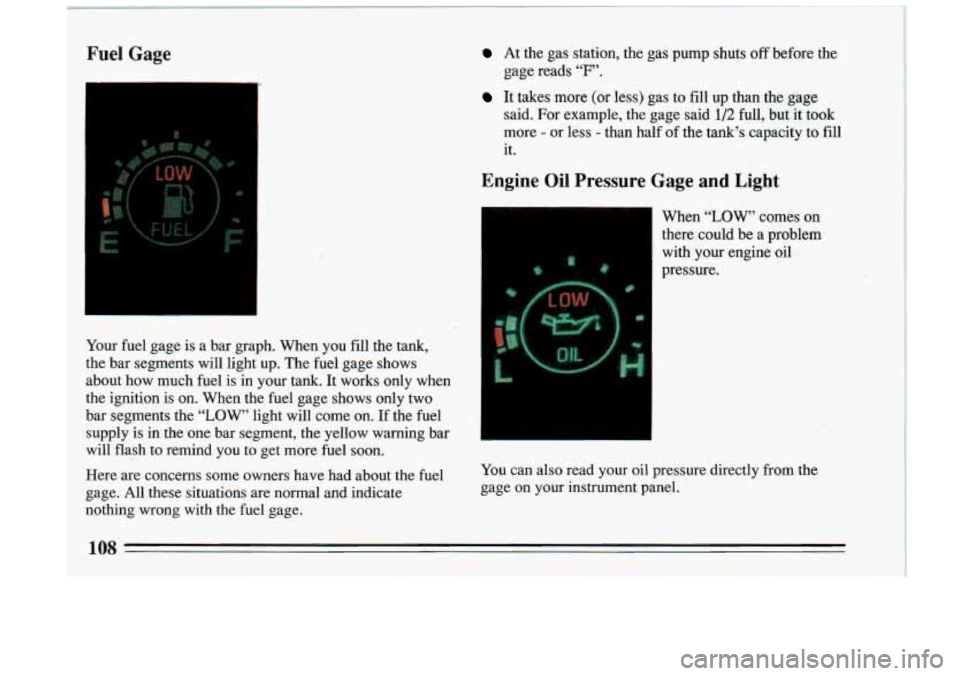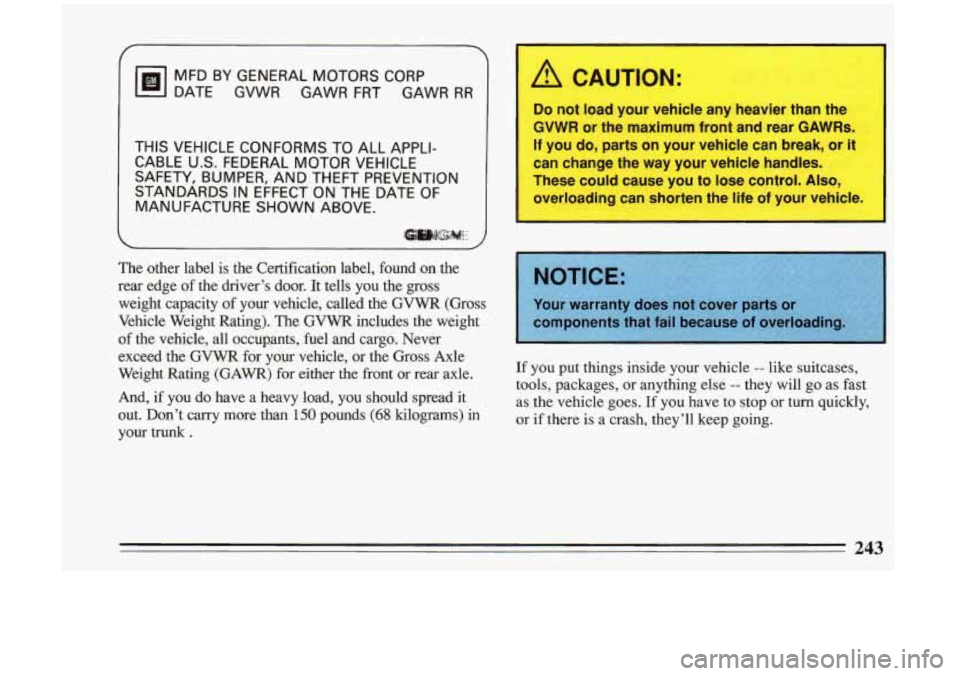Page 110 of 324

Fuel Gage
I
Your fuel gage is a bar graph. When you fill the tank,
the bar segments will light up. The fuel gage shows
about how much fuel is in your
tank. It works only when
the ignition is on. When the fuel gage shows only two
bar segments the
“LOW’ light will come on. If the fuel
~ supply is in the one bar segment, the yellow warning bar
’ will flash to remind you to get more fuel soon.
At the gas station, the gas pump shuts off before the
gage reads
“F’.
It takes more (or less) gas to fill up than the gage
said. For example, the gage said
1/2 full, but it took
more
- or less - than half of the tank’s, capacity to fill
it.
Engine Oil Pressure Gage and Light
When “LOW, comes on
there could be a problem
with your engine oil
pressure.
~ Here are concerns some owners have had about the fuel You
can also read your oil pressure directly from the
~ gage. All these situations are normal and indicate gage on you\
r instrument panel.
I
nothing wrong with the fuel gage.
j 108 I ~ 1 1
Page 222 of 324
Or you can use the release
lever
in the trunk.
While refueling, hang the cap inside the fuel door.
To take off the cap, turn it slowly to the left
(counterclockwise).
220
Page 226 of 324
Engine Oil
It’s a good idea to check your engine oil every time you
get fuel.
In order to get an accurate reading, the oil must
be warm and the vehicle must be on level ground.
The engine
oil dipstick.is
directly behind the engine
fan..
Turn off the engine and
give the oil a
few minutes
to drain back into the oil
pan.
If you don’t, the oil
dipstick might not show the
actual level.
To Check Engine Oil: Pull ’
1 out the dipstick and clean it
with a paper towel or cloth,
I.ii’ ” then push it back in all the
.. , way. Remove it again,
When to Add Oil: If the oil is at or below the ADD
mark, then you’ll need to add some oil. But you must
use tlwright kind. This section explains what kind
of oil
to use. For crankcase capacity, see “Capacities and
Specifications”
in the Index.
Page 245 of 324

7
Isl
MFD BY GENERAL MOTORS CORP
DATE GVWR GAWR FRT GAWR
RR
THIS VEHICLE CONFORMS TO ALL APPLI-
CABLE US. FEDERAL MOTOR VEHICLE
SAFETY, BUMPER, AND THEFT PREVENTION
STANDARDS IN EFFECT
ON THE DATE OF
MANUFACTURE SHOWN ABOVE.
@iwlIk$#d!!i
The other label is the Certification label, found on the
rear edge of the driver’s door. It tells you the
gross
weight capacity of your vehicle, called the GVWR (Gross
Vehicle Weight Rating). The
GVWR includes the weight
of the vehicle, all occupants, fuel and cargo. Never
exceed the GVWR for your vehicle, or the Gross Axle
Weight Rating
(GAWR) for either the front or rear axle.
And, if you do have a heavy load, YOU should spread it
out. Don’t carry more than
150 pounds (68 kilograms) in
your trunk
.
ur vehicle any heavier than the
:imum front
and rear GAWRs.
1 your vehicle can break, or it
lay your vehicle handles.
;e you
to lose control. Ako,
;horten the life of your vehicle. I
If you put things inside your vehicle -- like suitcases,
tools, packages, or anything else
-- they will go as fast
as the vehicle goes.
If you have to stop or turn quickly,
or if there
is a crash, they’ll keep going.
243
Page 279 of 324
TO BE SERVICED
(See Explanation of
Scheduled Maintenance
Services Following Schedules
I and 11)
Item No.
8. Spark Plug Replacement*
9. Spark Plug Wire Inspection*T
10. Air Cleaner Filter Replacement*
11. Fuel Tank, Cap
& Lines Inspection*?
WHEN TO PERFORM I MILES (000)
Miles (kilometers) or Months, Whichever
Occurs First I ,,
7.5 45 37.5 30 22.5 15
KILOMETERS (000)
0
0
Every 30 000 mi. (50 000 km) 0
0
I
The services shown in this schedule up to 45 000 miles (75 000 km) should be performed after 45 000 miles at the same
intervals.
I
* An Emission Control Service.
T The U.S. Environmental Protection Agency has determined that the failure to perform this maintenance item will not nullify the emission \
warranty or limit recall liability prior to the completion of
vehicle useful life. General Motors, however, urges that all recommended maintenance services be performed at the indicated intervals and the maintenance be recorded in “Section E:Maintenance
Record“.
277
Page 281 of 324

conditioning condenser. Wash the pressure cap and
neck.
To help ensure proper operation, we recommend a
pressure test of both the, cooling system and the
pressure cap.
7. Transaxle Service -- Change both the fluid and filter
every
15,000 miles (25 000 km) if the vehicle is
mainly driven under one or more of these conditions:
In heavy city traffic where the outside
temperature regularly reaches
90 F (32 C) or
higher.
In hilly or mountainous terrain.
Uses such as found in taxi, police car or delivery
If you do not use your vehicle under any of these
conditions, change both the fluid and filter every
100,000 miles (160 000 km).
8. Spark Plug Replacement* -- Replace spark plugs
with the proper type. See “Specifications Chart” in
the Index.
service.
9. Spark
Plug Wire Inspection*? -- Inspect for burns,
cracks or other damage. Check the boot fit at the
distributor and at the spark plugs. Replace wires as
needed.
10. Air Cleaner Filter Replacement* -- Replace every
30,000 miles
(50 000 km) or more often under dusty
conditions.
Ask your dealer for the proper
replacement intervals for your driving conditions.
11. Fuel Tank, Caa, and Lines Insa,ection*T -- Inspect
fuel tank, cap and lines (including fuel rails and
injection assembly, if equipped) for damage or leaks.
Inspect fuel cap gasket for an even filler neck
imprint or any damage. Replace parts as needed.
Periodic replacement of the fuel filter is not required.
i
* An Emission Control Service.
3‘ The U.S. Environmental Protection Agency has determined that the failure \
to perform this maintenance item will not nullify the emission warranty or limitrecall liability prior to the completion of vehicle
useful life. General Motors, however, urges that all recommended maintenance services be performed at the indicated intervals and the maintenance be recorded in “Section EMaintenance Record“.
1 279
1: